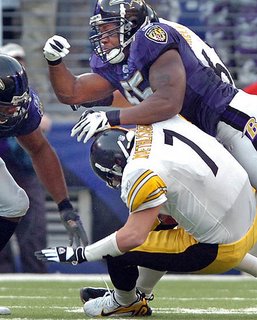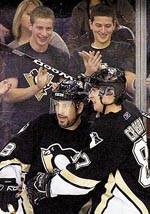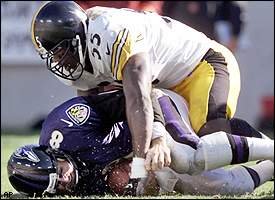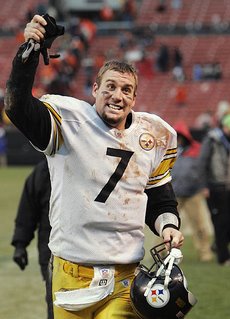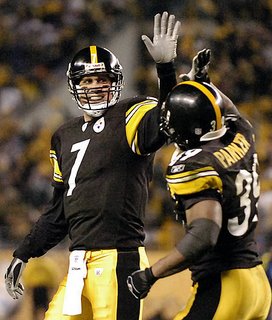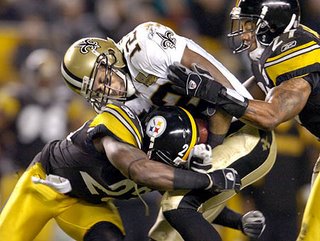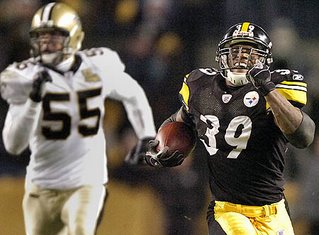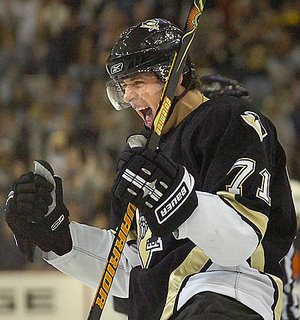
Wednesday, November 29, 2006
By Ed Bouchette, Pittsburgh Post-Gazette
Add another goal for the Steelers as they play out the string of five games: Do not let the quarterback get maimed.
How to keep Ben Roethlisberger healthy, happy and upright the rest of the season is a job that will fall on many people, including the quarterback.
NFL defenses sacked Roethlisberger 36 times in the 10 games he played. That's six more times than he was sacked last season and 13 times more than he was decked as a rookie.
Only one Steelers quarterback was sacked more in a season in the previous dozen years and that was Tommy Maddox, who was sacked 41 times in 2003 (Neil O'Donnell also was sacked 41 times in 1993). Only two Steelers quarterbacks have been sacked more often since the 1970 NFL merger -- Bubby Brister 45 times in 1989 and Cliff Stoudt 51 times in 1983.
At Roethlisberger's rate of 3.6 sacks per game played, he would hit the team's modern-day record in the next five games -- if he can last that long. He's listed as probable this week with an injury that came when halfback Willie Parker blew a blocking assignment and linebacker Bart Scott blew into Roethlisberger, bruising his chest. Roethlisberger left for one play but returned to finish the game.
"Ben wanted to be out there," Steelers coach Bill Cowher said. "It's one of those situations where you don't want to not be out there with the rest of your teammates who are out there fighting and battling. There's a lot to be said about that. ... I wasn't going to put him out there if there were risks medically. He fought through it like everybody else fought through it."
Scott's was the most brutal of Baltimore's nine sacks of Roethlisberger. That tied a Steelers record since the sack became an official stat in 1982 (12 is the team's unofficial record).
"The big hit he took, we actually repped that in practice," Cowher said. "Willie stepped up instead of stepping out. He should have taken the guy coming off the corner. Willie should have had it protected."
Roethlisberger took the blame for many of Sunday's sacks and Cowher tended to agree with him. He said he missed some "hot" routes, where a receiver will recognize a blitz and break off his route so the quarterback can get off a quick pass and avoid the sack.
"We didn't take advantage of that," Cowher said. "It's a risk-reward kind of thing. They took the risk but they got all of the reward. We really didn't hit the opportunities we had to make some big plays when we did that.
"There are other times where he should have thrown the ball away before he took the hit. There was a combination of all of those things."
The best way to protect the quarterback, though, is with a good running game and the Steelers have not had that consistently this season. Parker ranks third in the AFC with 915 yards and has a 4.4-yard average but the Steelers are only 17th in the NFL with 107.6 yards per game. They have run just 39.7 percent of the time, down from 57.2 percent last season.
"There's no question we've got to do that more effectively," Cowher said. "We've been playing a lot of catch-up and getting behind early. You want to stay with the running game and we probably abandoned it a little too soon the other day. I think the biggest thing is trying to put ourselves in the situation where we're not playing from behind the entire day."
A look at what transpired on offense in the first quarter in Baltimore shows the problems the Steelers had: Two passes on the first series around a 2-yard loss by Parker; a 12-yard run by Parker to start their second series, followed by two Parker runs for no gain and an incomplete pass; two runs by Parker for a total of 5 yards on the third series along with four passes and a sack for minus-11 yards.
The lack of production on first downs often left the Steelers with third-and-long and the Ravens blitzing.
"When you look at the third downs in the first half, we were 0 of 5," Cowher said. "But we didn't have one third down that was less than 10 yards. We had sacks. We had no-yard gains on first and second downs. Then we had three consecutive sacks on second down that led to third-and-longs.
"There's no question that you need just to get positive yards, just to get it back to manageable situations. Otherwise you're getting third downs and you're seeing us complete a 14-yard pass on third-and-19 because you just can't hold the ball against that type of team in that situation long enough to be able to get that many yards.
"There's no question, first and second down has a lot to do with that."
(Ed Bouchette can be reached at ebouchette@post-gazette.com. )

